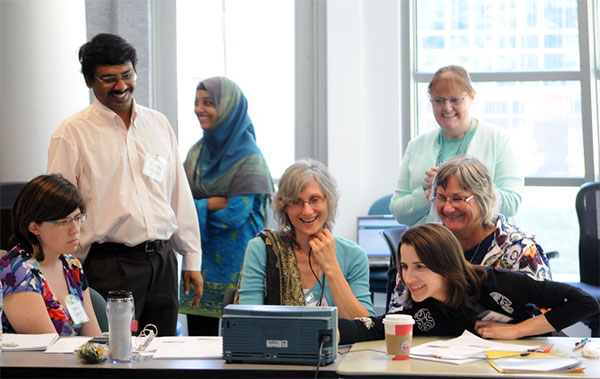NSF Grant to Help K-12 Teachers Teach the "Why?" Behind Math
January 28, 2015
When Padmanabhan “Padhu” Seshaiyer was a grade school student in India, he wanted to know the “why” behind math and science problems but instead had to stick with the traditional formula-based approach. He knew there had to be a better way.
He’s now a George Mason University math professor and is leading a $1.3 million National Science Foundation (NSF) grant to help K–12 teachers teach the reasoning behind math problems. The result could keep children interested in science and math through the challenging middle school years into college and throughout their lives, says Seshaiyer, who is the director of George Mason’s award-winning STEM Accelerator.
“When college students ask ‘Why should I care about math?’ it’s almost too late to answer that question,” Seshaiyer says. “Those questions need to be answered in grade school.”

Padmanabhan “Padhu” Seshaiyer is leading a $1.3 million National Science Foundation grant to help K–12 teachers teach the reasoning behind math problems.
The NSF grant is a “STEM-C targeted partnership” that will fund the three-year IMMERSION project in Virginia with Mason, in Montana with Montana State University and in California with Harvey Mudd College. Mason will work with 24 teachers from Fairfax County starting this summer. A total of 72 teachers from all three states will participate in the project each year.
The Mason-led program also brings together Mason professors from different disciplines. College of Education and Human Development professor Jennifer Suh specializes in mathematics teacher development and improving mathematics proficiency in students, and is working with Seshaiyer, who’s based in the College of Science, on the NSF grant. They’re also co-writing a book focused on teaching mathematical modeling in the elementary and middle grades.

Jennifer Suh, associate professor in the College of Education and Human Development at George Mason University, specializes in mathematics teacher development and improving mathematics proficiency in students. She is collaborating with Dr. Seshaiyer on the grant and a forthcoming book. Photo by Alexis Glenn.
IMMERSION will bring a concept called mathematical modeling into grade school classrooms. Mathematical modeling takes math out of the classroom and into the world, Suh explains. A thumb could be used as a unit of measurement or mathematical equations could be teased out of building a catapult.
“The idea is to inspire creativity so students can see math all around them and make connections,” Suh says.
And mathematical modeling is not watered down for the elementary set. “While it’s fun, it’s also complex enough to be challenging,” Seshaiyer says.
Teachers will have first-hand knowledge of how well the mathematical modeling approach works because they’ll be doing the work as students so they can learn what may stump a student or what may lead to that “a-ha” moment of understanding.
The teachers then will take the lesson and apply it to their classrooms. Suh and Seshaiyer will follow test scores and use the data for future research papers. The results could be seen in the upcoming generations of college students.
“I think teachers are the best group to spread the awareness of this approach,” Seshaiyer says. “It’s a chain reaction.”
This article originally appeared on Mason News.
About CEHD
George Mason University's College of Education and Human Development (CEHD) includes two schools: the Graduate School of Education, one of the most comprehensive education schools in Virginia, and the School of Recreation, Health, and Tourism. CEHD offers a full range of courses, certificates, and degree programs on campus, online, and on site to more than 4,000 students each year. CEHD is fully accredited by NCATE, and all licensure programs are approved by the Virginia Department of Education. George Mason University, located just outside of Washington, DC, is Virginia's largest public research university.
For additional information:
- CEHD Communications: cehdnews@gmu.edu
- Graduate School of Education: gse.gmu.edu
- Mathematics Education Leadership program: gse.gmu.edu/math
Follow CEHD on Facebook at www.facebook.com/MasonCEHD or Twitter at @MasonCEHD.
